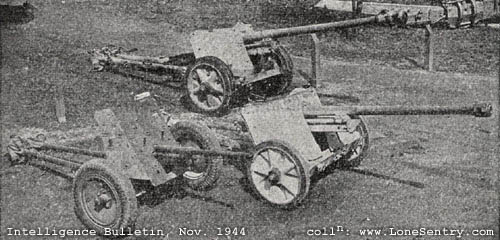
German antitank guns of the normal type. At the left is the 3.7-cm Pak; at the right, the 5-cm Pak 38; in the rear, the 7.5-cm Pak 40.
The German army issued a specification for a 75mm antitank gun (or Panzerahwehrkanone) to Krupp and Rheinmetall in 1939, but development was given low priority until the invasion of the Soviet Union on June 22, 1941, and the Germans’ first disturbing encounters with superior Soviet T-34 and KV-1 tanks and 76,2mm guns. The first PaK 40s arrived at the front in November 1941, and by 1943 it was the principal antitank gun for Germany and its allies.
Although the new 50- mm (1.97-in) Pak 38 gun had yet to reach the troops, it was felt that something heavier was going to be needed to counter the armour belts of the new Soviet tanks, and consequently Rheinmetall- Borsig was asked to produce a new design. In basic terms what Rheinmetall did was to scale up the Pak 38 design to the larger calibre of 75mm (2.95 in). The result was adopted in 1940 as the 7.5-cm Pak 40, but it was not until late in the following year that the first examples reached the hard-pressed troops on the Eastern Front.
In appearance the Pak 40 resembled its predecessor, but there were many differences apart from the scale. The basic layout of the 50-mm (1.97-in) gun was retained but this time the expected shortages of many raw materials and especially light alloys (which had been earmarked for the Luftwaffe production requirements) were becoming apparent, so the Pak 40 was constructed mainly from various forms of steel and was proportionately much heavier than the smaller gun. To simplify and speed production the shield was formed from flat instead of curved plates, and there were several other such alterations. The result was an excellent gun, well capable of tackling virtually any Allied tank and encountered on all fronts.
The Pak 40 was destined to remain in production until the end of the war in 1945. It had a tank gun equivalent that was progressively developed, but the Pak 40 itself remained in service virtually unchanged. A version intended for use as an aircraft weapon was developed, and the carriage was even adapted at one stage to allow short 75-mm (2.95-in) barrels to be fitted to produce a form of infantry/anti-tank gun for use by infantry formations. The gun itself was even placed on a 105- mm (4.14-in) howitzer carriage to form a light field artillery piece, though another approach was to use the Pak 40 itself as a field gun, and by 1945 there were several artillery formations using this gun as the 7.5-cm FK 40 (FK for Feldkanone, or field gun).
But it was as an anti-tank gun that the Pak 40 was most important. Many German gunners rated it their best all-round weapon, and many Allied tank crews had occasion to agree with them, The Pak 40 fired a wide range of ammunition, varying from the straightforward solid armour-piercing shot to the tungsten-cored AP40. Also available were high explosive shells that carried enough payload to make the type a useful field artillery piece, and various forms of hollow-charge projectile.
With an effective range of 1,800 meters, the PaK 40 could fire a 75mm armour-piercing round at 792 meters per second, enabling it to penetrate up to 132mm of steel. A tungsten-cored round was later developed with a muzzle velocity of 933 meters per second, able to pierce 154mm of armour-virtually any Allied tank except for the Soviet lS-2 and American M26 Pershing, Too heavy to be moved through mud, snow or rough terrain without an artillery tractor, the PaK 40 was mounted on a wide variety of chassis to counter the overwhelming number of Allied tanks with self-propelled antitank weapons. After the war, Albania, Bulgaria, Czechoslovakia, Hungary, Romania and other countries continued to use the gun.
Specification 7.5 cm Pak 40
Calibre: 75 mm (2.95 in)
Length of piece: 3.7 m (12 ft 1.7 in)
Length of rifling: 2.461 m (8 ft)
Weight: travelling 1500 kg (3,307 lb) and in action 1425 kg (3,141.5 lb)
Traverse: 45°
Elevation:-5° to+22°
Muzzle velocity: AP 750 m (2,460 ft) per second, AP40 930 m (3,050 ft) per second and HE 550 m (1,805 ft) per second
Maximum range: HE 7680 m (8,400 yards)
Projectile weight: AP 6.8 kg (15 lb), AP40 4.1 kg (9.04 lb) and HE 5.74 kg (12.65 lb)
Armour penetration: 98 mm (3.86 in) at 2000 m (2,190 yards)